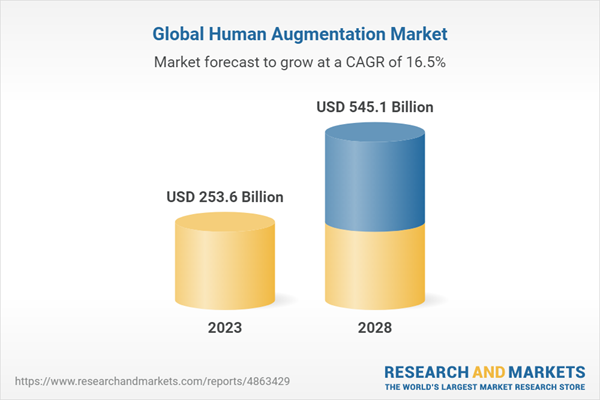Dublin, Jan. 31, 2024 (GLOBE NEWSWIRE) -- The "Global Human Augmentation Market by Wearable (Wristwear, Bodywear, Footwear, Eyewear), AR (Head-mounted display), VR (Head-up display), Biometric (Fingerprint, Face, Iris), Exoskeleton (Powered, Passive), IVA (Chatbot), Functionality - Forecast to 2028" report has been added to ResearchAndMarkets.com's offering.
The global human augmentation market is expected to be valued at USD 253.6 billion in 2023 and is projected to reach USD 545.1 billion by 2028; it is expected to grow at a CAGR of 16.5% from 2023 to 2028.This report categorizes the Human Augmentation market by Product Type, Functionality, Technology, End-user, and Region.
Wearable devices, such as fitness trackers and smartwatches, are widely adopted for monitoring various health and wellness metrics. The widespread adoption of wearable devices in the consumer market indicates a growing interest in incorporating technology into daily life. This increased acceptance has spilled over into the broader human augmentation market, raising awareness and driving further innovation.
The key players operating in the human augmentation market are Samsung (South Korea), Alphabet Incorporation (US), Apple Inc. (US), Meta (US), Microsoft (US).

Aerospace and Defense end-user industries to account for the second highest CAGR for human augmentation market
The military and defense sector is investing heavily in human augmentation technologies to enhance the physical and cognitive capabilities of soldiers. Exoskeletons, wearable devices, and cognitive enhancements can improve soldiers' strength, endurance, and decision-making, increasing their overall performance and effectiveness. AR and VR technologies are used for training, simulation, and mission planning. These technologies provide immersive experiences for soldiers and defense personnel, enhancing their skills and preparedness. Advances in technology have led to the development of lightweight, portable, and durable human augmentation devices that are suitable for use in the challenging and rugged environments encountered in the aerospace and defense sectors.
North America to have the highest share of the human augmentation market
North America, particularly the United States, is a hub for technological innovation. Ongoing advancements in fields like robotics, artificial intelligence, biotechnology, and materials science are driving the development of advanced human augmentation technologies. The demand for medical augmentations, such as prosthetics, wearable medical devices, and surgical robotics, is increasing due to a growing aging population and the need for advanced healthcare solutions. The consumer market for human augmentation includes products like fitness wearables, smart glasses, and brain-computer interfaces. These consumer-oriented technologies are contributing to the market's growth.
Market Dynamics
- Drivers
- Growth in Virtual Reality (VR) and Augmented Reality (AR) Technologies
- Advancements in Medical Technology
- Increasing Adoption of Wearable Devices
- Growing Adoption of Advanced Technologies in Sports
- Restraints
- High Costs Associated with Human Augmentation Technologies
- Integration Issues with Existing Systems
- Opportunities
- Growing Adoption of Human Augmentation Technologies in Military and Defense Sector
- Shift Toward Remote Work and Telemedicine
- Emerging Applications of Human Augmentation Technologies in Gaming and Entertainment Industries
- Challenges
- Long-Term Health Effects and Biocompatibility Issues Related to Prolonged Use of Human Augmentation Technologies
- Safety and Liability Issues Associated with Augmentation Devices
Technology Analysis
- Key Technologies
- Exoskeletons
- Augmented Reality (AR) and Virtual Reality (VR)
- Brain-Computer Interfaces (BCIS)
- Biotechnology and Biohacking
- Prosthetics and Bionics
- Complementary Technologies
- Artificial Intelligence (AI)
- Internet of Things (IoT)
- Biometrics and Biosensors
- Cybersecurity
- Adjacent Technologies
- Biomechanics and Robotics
- Biotechnology and Regenerative Medicine
- Sensors and Wearable Technology
- Materials Science
Case Study Analysis
- Pfizer Collaborated with Magic Leap to Develop Mixed-Reality Solution for Drug Discovery and Visualization
- Toyota Motor Manufacturing Implemented Exoskeletons from Ekso Bionics in Its Manufacturing Facilities
- General Motors Partnered with Sarcos Robotics to Deploy Wearable Exoskeletons for Factory Workers
- Siemens Power Generation Services Collaborated with Realwear to Enhance Remote Technical Support Using AR Technology
- Mercedes-Benz Streamlined Repair Procedures by Equipping Technicians with Google's Glass Enterprise Edition AR Glasses
Key Attributes
| Report Attribute | Details |
| No. of Pages | 286 |
| Forecast Period | 2023-2028 |
| Estimated Market Value (USD) in 2023 | $253.6 Billion |
| Forecasted Market Value (USD) by 2028 | $545.1 Billion |
| Compound Annual Growth Rate | 16.5% |
| Regions Covered | Global |
Companies Mentioned
- Alphabet
- Apple Inc.
- Atheer, Inc
- B-Temia
- Casio Computer Co. Ltd.
- Cortigent
- Cyberdyne Inc.
- Cyberglove Systems Inc.
- Ekso Bionics
- Fossil Group Inc.
- Garmin Ltd.
- Goqii
- HK Smartmv Limited
- Inbenta Holdings Inc.
- Lifesense
- Magic Leap, Inc.
- Merge Labs, Inc.
- Meta
- Microsoft
- Mycroft AI, Inc.
- P&S Mechanics Co. Ltd.
- Polar Electro
- Rewalk Robotics
- Rex Bionics Ltd.
- Samsung
- Scope AR
- Sony Group Corporation
- Vuzix
- Wearable Robotics Srl
For more information about this report visit https://www.researchandmarkets.com/r/iqq0qh
About ResearchAndMarkets.com
ResearchAndMarkets.com is the world's leading source for international market research reports and market data. We provide you with the latest data on international and regional markets, key industries, the top companies, new products and the latest trends.
Attachment
